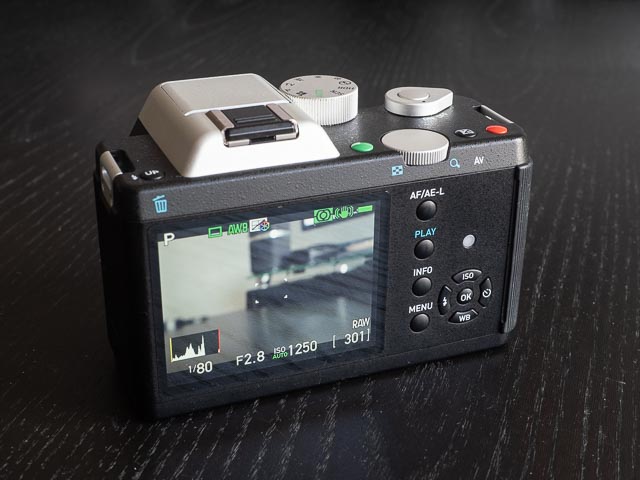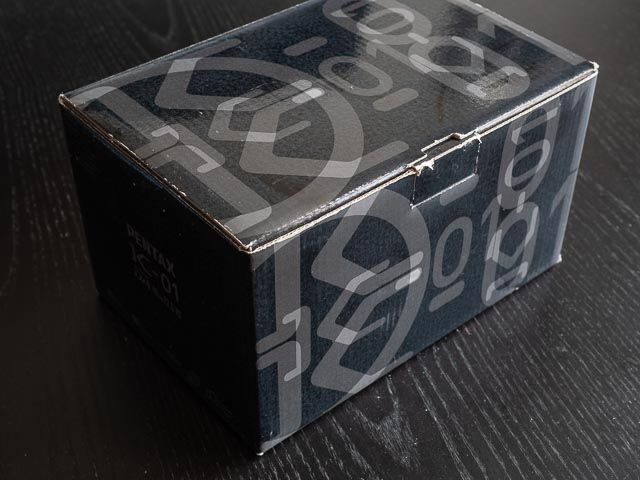Pentax K-01
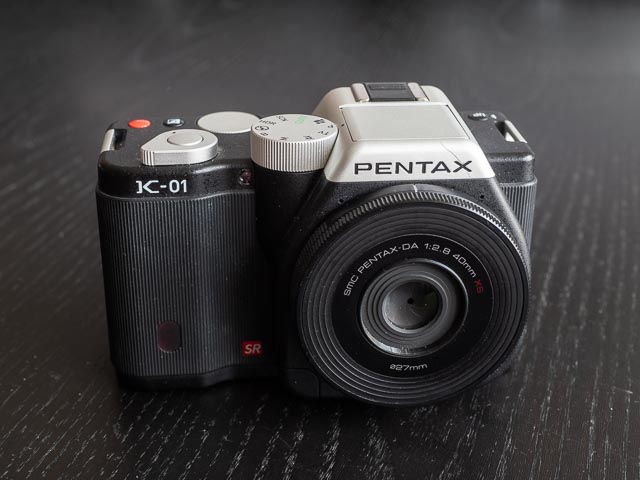
Introduction
| Launch date | Feb 2012 |
|---|---|
| Camera type | Mirrorless interchangeable lens camera |
| Camera size | 561 grams 122 x 79 x 58 mm (inc. battery) |
| Camera size (inc. 40mm F2.8 XS) |
613 grams 122 x 79 x 67 mm (inc. battery) |
| Sensor type | CMOS |
| Sensor size | APS-C (23.7 x 15.7 mm) |
| Resolution | 4928 x 3264 (16 megapixels) |
| Lens | interchangeable (Pentax K mount) |
If you just want to see some photographs, skip straight to the results section.
As all the other major camera makers continue move to move entirely away from the traditional DSLR interchangeable lens cameras to their modern mirrorless equivalents, Pentax have made it clear that they're sticking with the DSLR. This completes Pentax's journey (that actually started a long time ago) from one of the biggest and most influential mainstream camera manufacturers to a niche, boutique specialist. But I for one am glad that there is still room for such specialists in todays market place, even if I'm not a regular DSLR user myself anymore.
But that doesn't mean Pentax has always felt this way… in the early days of mirrorless cameras they to had a go at at this type of camera! But even with mirrorless, Pentax took a decidedly niche approach rather than attempt to compete directly with the mainstream mirrorless market leaders. This started with the Pentax Q in 2011: a mirrorless camera with the kind of small sensor you'd normally find in a fixed-lens digicam, and continued with the Pentax K-01 camera you can see here, launched in 2012.
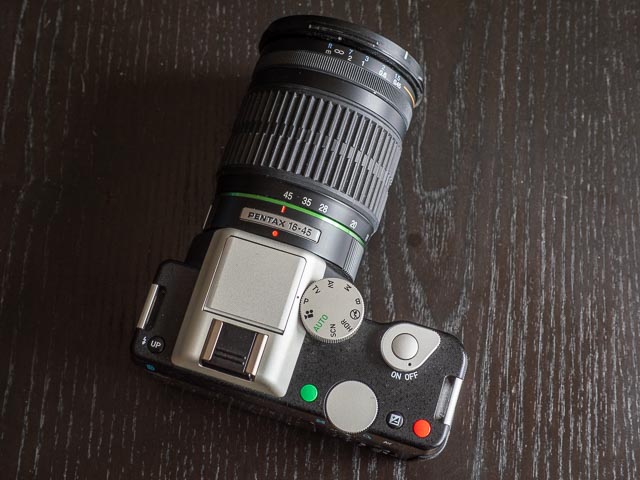 The Pentax K-01 used the same APS-C sensor as Pentax's contemporary K-5 and K5 II DSLRs. But instead of pairing it with a new mirrorless specific lens mount, like pretty much every other camera maker did, they used the lens mount from their DSLRs: the venerable Pentax K mount. This had a big disadvantage: it made the K-01, and the lenses you had to use with it, considerably larger than the competing mirrorless system. Here you can see the K-01 mounted with a reasonably modest 16-45mm f/4.0 zoom lens, and it's already is starting to look a little ungainly. It also had one huge advantage: it means the K-01 launched with an extensive range of compatible lenses right from the get-go.
The Pentax K-01 used the same APS-C sensor as Pentax's contemporary K-5 and K5 II DSLRs. But instead of pairing it with a new mirrorless specific lens mount, like pretty much every other camera maker did, they used the lens mount from their DSLRs: the venerable Pentax K mount. This had a big disadvantage: it made the K-01, and the lenses you had to use with it, considerably larger than the competing mirrorless system. Here you can see the K-01 mounted with a reasonably modest 16-45mm f/4.0 zoom lens, and it's already is starting to look a little ungainly. It also had one huge advantage: it means the K-01 launched with an extensive range of compatible lenses right from the get-go. 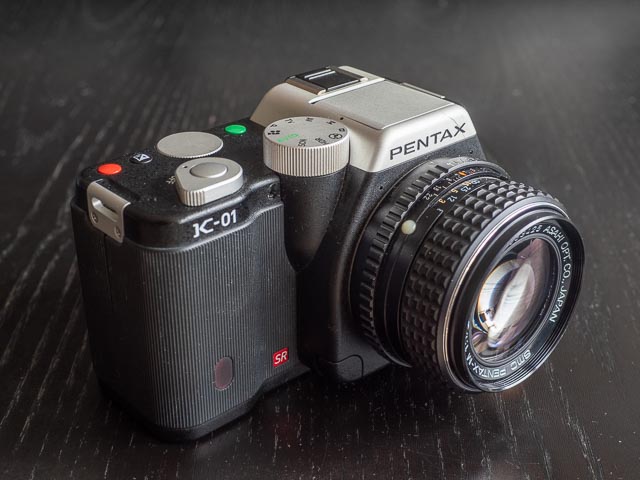 Not only that, it also meant you could use any vintage Pentax K mount lens made since that lens mount was introduced in 1975. Here you can see the K-01 mounted with a vintage SMC Pentax-M 50mm f/1.4 lens from 1977.
Not only that, it also meant you could use any vintage Pentax K mount lens made since that lens mount was introduced in 1975. Here you can see the K-01 mounted with a vintage SMC Pentax-M 50mm f/1.4 lens from 1977.
In an attempt to mitigate the fact that the K-01 was quite a bit bigger than it's competitors, Pentax also launched the first of what was supposed to be a range of ultra-compact lenses: the SMC Pentax-DA 40mm f/2.8 XS, just 9mm long and just 52 grams in weight. But history tells us that the Pentax K-01 was one of the biggest flops in Pentax's entire history, and the 40mm f/2.8 XS wasn't just the first XS lens… it was also the last.
 Fortunately Pentax have long history of making a range of very compact prime lenses in their "Ltd" range with focal lengths of 15, 21, 35, 40, and 70mm which are the perfect size to complement the K-01. Here you can see the K-01 fitted with the MC Pentax DA Limited 21mm f/3.2 lens.
Fortunately Pentax have long history of making a range of very compact prime lenses in their "Ltd" range with focal lengths of 15, 21, 35, 40, and 70mm which are the perfect size to complement the K-01. Here you can see the K-01 fitted with the MC Pentax DA Limited 21mm f/3.2 lens.
But it wasn't just the size that put off both newcomers and the Pentax faithful; the aesthetics and ergonomics of the K-01 also caused a great deal of controversy! The camera was designed by Australian industrial designer Marc Newson, a designer not known for camera design. And the squared-off brick like shape, combined with toy like coloured buttons generated a lot of what can only be called derision on the 'net. Before the full extent of the backlash against the design became aparent, the following Marc Newson interview about the design of the K-01 was published. It perhaps only serves to reveals Mark Newson's inexperience in the very specialist field of camera design. He talks a lot in the interview about how photographs and photography influences and inspirers his work, but only in the most vague and non-specific terms. The interview does make it seem like he isn't really interested in practicing photography as a hobby in it's own right himself.
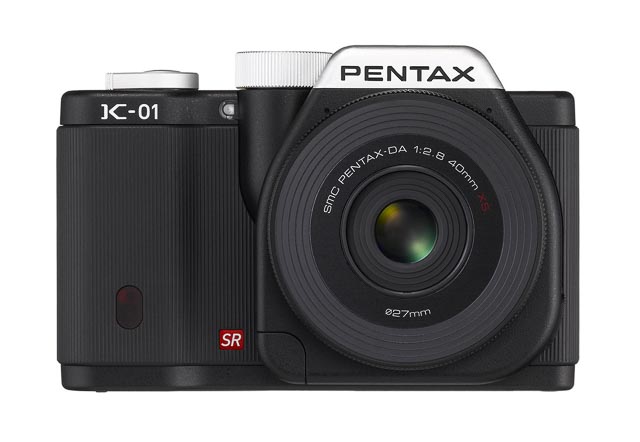



The Pentax K-01 was launched in three colour schemes
- black and yellow,
- black with silver controls (which is the color scheme for my camera),
- and black/white with black controls.
Later on a blue and white model with black controls was released exclusively for the Japanese market. I have to say I rather like the styling of this camera, though sometimes I feel like the only person in the world who does! The combination of good build quality, rubber, child-like buttons and a rare sparse layout is very different from any other camera out there. But even though I like this camera's aesthetics, even I have to admit that the ergonomics are bad, which brings us on to…
The Pentax K-01 in use
Yeah… the K-01's ergonomics… really are shamefully bad. The ergonomics, more than anything else, are was really shows Mark Newson's lack of experience in camera design. This camera was nick-named "the brick" in reference to it's brick like proportions and shape, and that's pretty much what it feels like to hold too. It can be really difficult to reach all the controls without uncomfortably shifting your hand position too. The controls them self are simple and clear, which is actually really nice, but that doesn't fully compensate for the difficulty in finding a comfortable hold. It impossible not to come to the conclusion that this camera was designed by someone who was never going to actually use this camera.
And then there's the K-01's biggest bit of missing functionality: there's no eye-level viewfinder… not even the possibility to add one as an accessory. All your photographs have to be composed on the fixed rear monito. Now I've said several times on these pages that I actually quite like composing photographs on a flat "photograph-like" screen, and I really do. But even so, there are times when a monitor really doesn't work very well. Using a camera in bright sunshine is one example, and manually focussing vintage lenses (which in other ways the K-01 is ideal for!) is another. So at least having an option to use an accessory eye-level viewfinder is pretty important. I think this was one of the biggest things that made the Pentax-faithful (who are, it has to be said, very attached to their optical eye-level DSLR viewfinders!) dissmiss the K-01 out-of-hand on first sight. If the K-01 had been more successful then an add-on eye-level viewfinder might have featured on the K-02 (in much the same way as the Olympus E-P1 had no option for an add-on eye-level viewfinder, but the E-P2 did), but as we know, a K-02 was never to be!
But here's the thing; despite the K-01's multiple and manifest ergonomic failings, I find this camera a huge amount of fun to use! It's never going to spend much time in my regular rotation of cameras, but when I do take it out I have a lot of fun with it!
Some of this is to do with the superb system Pentax designed for working with vintage Pentax K lenses, even those that lack electronic contacts. You just set the mode dial to 'M' for manual mode, set the aperture ring to the f-stop you required, then you just hit the green button on the top of the camera. The camera then automatically stops down the lens to the taking aperture you've just set, takes a meter reading, and then sets the correct shutter speed. I really is impossible to think of any way the process could be made any smoother. Pentax's green button system (taken straight from it's DSLR cameras) really is the best in the business for dealing with vintage lenses. And if you have a slightly more recent Pentax manual focus lens with electronic contacts (denoted by an 'A' in the lens name and the 'A' setting on the aperture ring) things are even easier: apart from having focus manually you'd hardly know you didn't have a brand-new modern lens on your camera. And all vintage auto-focus lenses work with full functionality… you really can just treat them like modern lenses.
For fans of vintage Pentax lenses the K-01 really is a dream mirrorless camera! At least it would be if it had an eye-level viewfinder.
Pentax K-01 results
This is the bit where the Pentax K-01 starts to gain ground on it's competitors, even for those who exclusively want to use modern lenses. The K-01 was widely praised for the image quality of it's 16mp APS-C sensor that also featured in the top of the range K-5 and K-5 II DSLRs from this period. And it really is capable of giving some very lovely results. These example were all shot on just one lens: the SMC Pentax-DA 40mm f/2.8 XS that was effectively the kit lens for the K-01. This lens is the real reason I bought this camera (which was part of a K-01 and 40mm XS kit) back in 2015. I suppose what I really wanted was the rather lovely
SMC Pentax-DA 40mm F2.8 Limited lens, but at the time this camera, complete with the SMC Pentax-DA 40mm f/2.8 XS, cost considerably less 2nd hand than the Limited lens cost on it's own. So I was able to persuade myself that the camera wasn't really costing me anything at all! (A typical tactic of someone suffering from G.A.S.  )
)
This unique camera never did see a huge amount of use, but I'm now very happy to call it part of my camera collection.













That last one is actually a stitched panorama created from 6 individual vertical shots, which is why it's far more wide-angle than a 40mm lens on an APS-C sensor normally would be.
